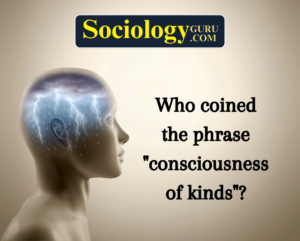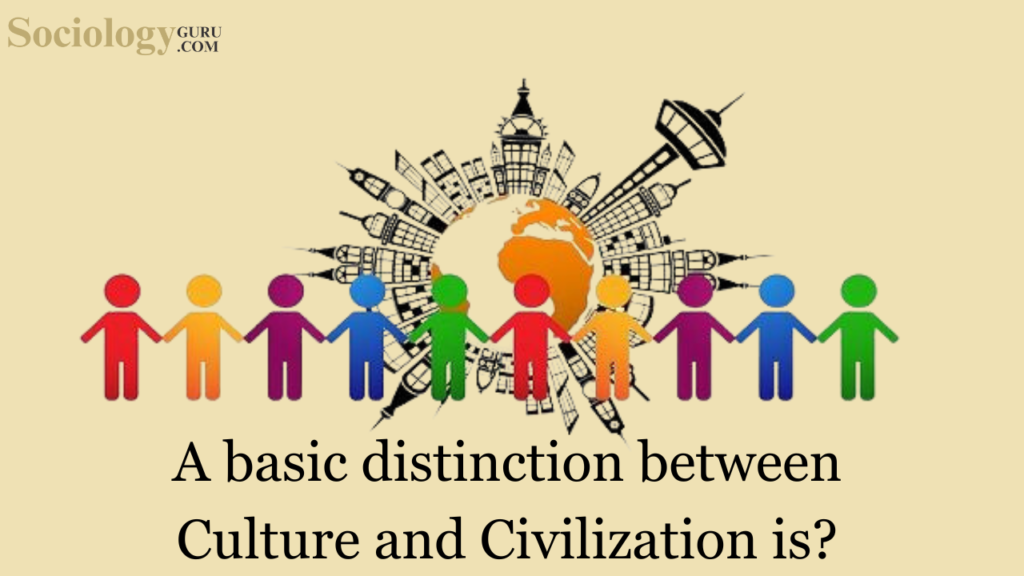Question: Who coined the phrase “consciousness of kinds”?
- E. Durkheim.
- Giddings
- T. Veblen
- Hegel
Answer: (2)The question in focus pertains to the coining of the phrase “consciousness of kinds,” and the options provided are (a) E. Durkheim, (b) Giddings, (c) T. Veblen, and (d) Hegel. The correct answer is (b) Giddings. Lester Frank Ward Giddings was an American sociologist who made significant contributions to the field, and his doctrine of the “consciousness of kind” stands as a notable concept in sociological thought. Lester F. Ward Giddings developed the concept of “consciousness of kind” as a key element in his sociological framework. He drew inspiration from Adam Smith’s notion of “sympathy” or shared moral reactions, adapting and expanding it to form his own theoretical construct. Giddings’s exploration of consciousness of kind aimed to understand the factors that contribute to social cohesion and the formation of a homogeneous society. Giddings argued that the consciousness of kind arises from the interactions between individuals and their exposure to common stimuli. This shared awareness of belonging to a particular social group or community forms the basis for social solidarity. It goes beyond mere individual experiences and encompasses a collective understanding of shared values, norms, and moral reactions. To delve deeper into Giddings’s concept of consciousness of kind, it is crucial to explore the intellectual context in which it emerged. Giddings was writing during a period marked by rapid industrialization, urbanization, and social change in the late 19th and early 20th centuries. These societal transformations prompted sociologists to grapple with the challenges of maintaining social order and cohesion in the face of increasing diversity and complexity. Adam Smith’s concept of sympathy, as outlined in his work “Theory of Moral Sentiments,” laid the groundwork for Giddings’s development of consciousness of kind. Smith argued that individuals have an innate capacity for empathy and moral sentiments, allowing them to understand and share in the emotions and experiences of others. Giddings expanded this idea to suggest that, through interactions and shared experiences, individuals develop a consciousness of belonging to a particular social group. Giddings’s perspective on consciousness of kind can be viewed as an attempt to reconcile the individualistic tendencies emphasized by classical liberal thought with the need for social cohesion in an evolving society. By highlighting the role of shared experiences and interactions in fostering a sense of commonality, Giddings sought to address concerns about the potential fragmentation of society in the face of increasing individualism. However, as with any theoretical concept, Giddings’s notion of consciousness of kind faced criticism. Some critics viewed it as a euphemism for the “herd instinct,” implying a conformity-driven aspect to social cohesion. The term “herd instinct” was often used pejoratively to suggest that individuals might be driven by an innate inclination to conform to group norms, potentially stifling individual autonomy and diversity of thought. In evaluating Giddings’s concept, it is essential to recognize the broader implications and applications of consciousness of kind in sociological discourse. The concept has been influential in discussions on social identity, group formation, and the dynamics of collective behavior. It offers a lens through which sociologists can examine how shared experiences and a sense of belonging contribute to the cohesion and stability of social groups. Giddings’s work on consciousness of kind also intersects with broader debates within sociology regarding the nature of social solidarity. Émile Durkheim, for instance, explored the concept of mechanical and organic solidarity, emphasizing the integration of individuals in traditional and modern societies. While Durkheim’s approach differed from Giddings’s, both scholars grappled with questions related to social order and integration in the face of societal changes. Furthermore, Giddings’s focus on consciousness of kind resonates with themes in the works of Thorstein Veblen. Veblen, an American economist and sociologist, examined the role of social norms and institutions in shaping individual behavior. Giddings’s emphasis on shared moral reactions and common stimuli aligns with Veblen’s broader exploration of the interplay between societal influences and individual actions. In conclusion, the phrase “consciousness of kind” was coined by Lester F. Ward Giddings, a prominent American sociologist. Giddings’s conceptualization of consciousness of kind drew inspiration from Adam Smith’s idea of sympathy and aimed to elucidate the mechanisms through which individuals develop a shared awareness of belonging to a particular social group. This concept played a significant role in Giddings’s broader sociological framework, addressing the challenges of social cohesion in the context of evolving societies. Despite facing criticism, consciousness of kind remains a valuable lens through which sociologists analyze the dynamics of group formation, identity, and collective behavior in diverse social contexts. |
Take a Quick Sociology Quiz to measure your Performance
Frequently Asked Questions:
1. Question: Define the term “ethnic movement” and provide an example from India.
Answer: An ethnic movement refers to a collective effort by a group sharing common cultural, linguistic, or religious traits, seeking to assert their identity and rights; an example from India is the Khalistan Movement in Punjab.
2. Question: Identify the main objectives behind the Gorkhaland ethnic movement.
Answer: The Gorkhaland ethnic movement primarily seeks to establish a separate state for India’s Nepali-speaking population in the Darjeeling region, advocating for linguistic and cultural recognition and political autonomy.
3. Question: What was the Operation Blue Star, and which ethnic movement was it related to?
Answer: Operation Blue Star was a military action in 1984, aiming to remove Sikh militants hiding in the Golden Temple in Amritsar; it is related to the Khalistan movement, which sought a separate Sikh country.
4. Question: Mention a critical factor that triggered the emergence of ethnic movements in India, as discussed by Dipankar Gupta.
Answer: Dipankar Gupta emphasized that ethnicity is fundamentally a political process, wherein caste and religion, the key components of identity formation, are politicized by leaders for vested interests.
5. Question: What were the primary reasons for the Assam Ethnicity conflicts involving Bodo tribals and Bengali Muslim settlers?
Answer: The Assam Ethnicity conflicts primarily stemmed from issues related to immigration, land rights, and resource allocation, leading to clashes, riots, and evolving relationships among indigenous communities to address challenges.
6. Question: Briefly describe the role of the Dravidian Movement in terms of caste and societal structure.
Answer: The Dravidian Movement, led notably by E.V. Ramasamy, aimed to establish an egalitarian society, focusing on anti-Brahmanism and advocating for equal rights for backward castes, while also introducing reforms like self-respect marriages.
7. Question: Name the prominent ethnic movements in North-East India and specify one common objective.
Answer: Prominent ethnic movements in North-East India include the Nagas’ and Mizos’ struggles; a common objective was to gain autonomy and recognition for their distinct tribal identities and cultural uniqueness.
8. Question: What is the key argument of Gail Omveldt regarding traditional Indian society and multiculturalism?
Answer: Gail Omveldt opposed romanticizing traditional Indian society, arguing that hierarchy has always dominated it and dismissing the notion that multiculturalism is an intrinsic feature of Indian society as a myth.
9. Question: Briefly explain the social hierarchy factor as a contributing element to ethnic movements as suggested by Olzak.
Answer: Olzak suggests that the construction of hierarchies among ethnic communities, which often leads to the suppression of one group by another, is a key factor that can instigate social and ethnic movements.
10. Question: Identify one consequence of the unequal economic development factor within the context of ethnic movements in India.
Answer: One consequence of unequal economic development is the marginalization and underdevelopment of certain groups, leading to feelings of alienation and sometimes initiating ethnic movements as these groups strive for equality and recognition.
To master these intricacies and fare well in the Sociology Syllabus, aspiring sociologists might benefit from guidance by the Best Sociology Teacher and participation in the Best Sociology Coaching. These avenues provide comprehensive assistance, ensuring a solid understanding of sociology’s diverse methodologies and techniques.
META TAGS:
Why Vikash Ranjan’s Classes for Sociology?
Proper guidance and assistance are required to learn the skill of interlinking current happenings with the conventional topics. VIKASH RANJAN SIR at SOCIOLOGY GURU guides students according to the Recent Trends, making him the Best Sociology Teacher for Sociology.
At Sociology Guru, the Best Sociology Coaching platform, we not only provide the best study material and applied classes for Sociology but also conduct regular assignments and class tests to assess candidates’ writing skills and understanding of the subject.
Choose The Best Sociology Teacher for your Preparation?
To master these intricacies and fare well in the Sociology Syllabus, aspiring sociologists might benefit from guidance by the Best Sociology Teacher and participation in the Best Sociology Coaching. These avenues provide comprehensive assistance, ensuring a solid understanding of sociology’s diverse methodologies and techniques. Sociology, Social theory, Best Sociology Teacher, Best Sociology Coaching, Sociology Syllabus.
Best Sociology Teacher, Sociology Syllabus, Sociology, Sociology Coaching, Best Sociology Coaching, Best Sociology Teacher, Sociology Course, Sociology Teacher, Sociology Foundation, Sociology Foundation Course, Sociology CUET, Sociology for IAS, Sociology for UPSC, Sociology for BPSC, Sociology for UGC NET, Sociology for JPSC,
Follow us :
KEYWORD:-Consciousness of Kinds, Consciousness of Kinds, Consciousness of Kinds, Consciousness of Kinds, Consciousness of Kinds, Consciousness of Kinds, Consciousness of Kinds, Consciousness of Kinds, Consciousness of Kinds, MA CUET SOCIOLOGY



